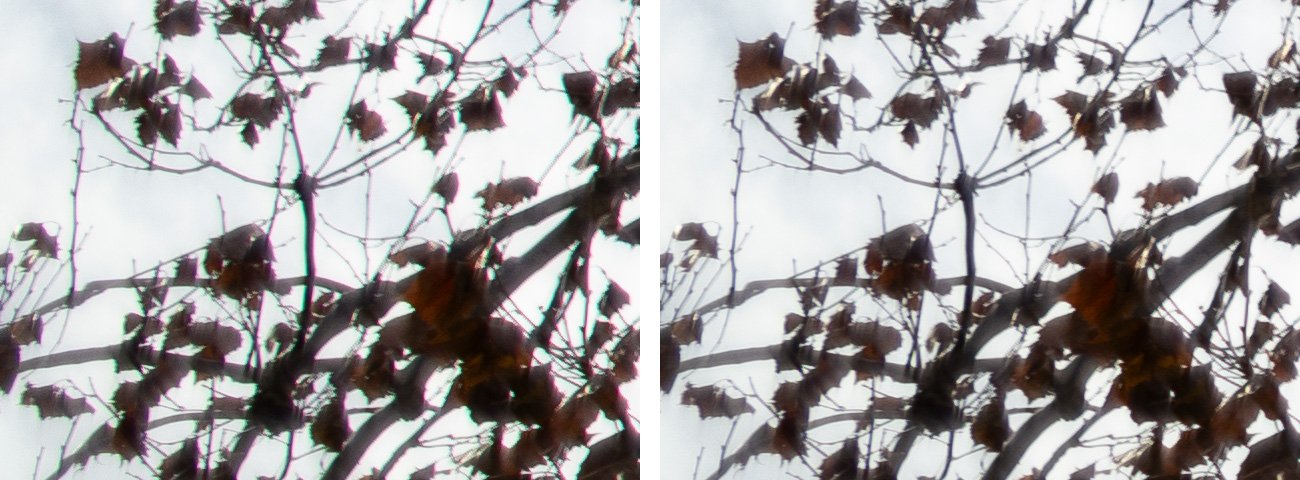Lens Basics for Architectural Photography
Lenses are essential tools in every photographer's kit. While they're complex to manufacture, learning how they work in practice often takes time and experience. To understand how to choose the right lenses for architectural photography, let's start with the basics of what lenses are and what they do, including some important terminology.
Basic Principles and Terminology
A simple lens is a single piece of transparent glass with at least one curved surface. Photographic lenses are compound lenses made from individual elements sharing a common optical axis, housed and protected within a lens barrel. The lens gathers light and bends it to converge onto an aperture. Light exits the lens through its rear nodal point and is projected onto a recording medium, producing a sharp image of the subject.
Aperture
The aperture is a circular opening that controls the volume of light entering the camera, working in conjunction with the shutter. It also affects depth of field and image sharpness.The aperture is adjusted using a ring on the lens barrel. Aperture values are written as f-numbers, representing the diameter as a fraction of the focal length. For example, f/8 on a 50mm lens has a diameter of 6.25mm (50mm ÷ 8 = 6.25mm). On a 150mm lens, f/8 will be three times larger.
Illustration of variable aperture on a 75mm Rodenstock Grandagon-N lens. From left: f/5.6, f/13, f/45.
Depth of Field
Depth of field refers to the zone of acceptable sharpness within an image. It's the range of distances in a scene that appears in focus. The aperture plays a crucial role in determining the extent of the depth of field.
Smaller apertures (higher f-numbers) increase depth of field. This means that more of the scene, from foreground to background, will appear sharp. This is often desirable in architectural photography, where we typically want to have the entirety of the building in focus.
Larger apertures (lower f-numbers) decrease depth of field. This results in a shallower zone of focus, where only a select area is sharp, while the rest of the image is defocussed, or blurred. This can be used creatively to isolate a particular architectural detail or create a sense of depth.
The choice of aperture depends on the desired creative effect and the specific requirements of the architectural scene. The middle aperture value of the lens generally provides the best balance between sharpness and diffraction.
To maximize depth of field, especially in landscape and cityscape photography, photographers often use the concept of hyperfocal distance. This involves focusing at a specific distance to achieve the greatest possible zone of sharpness.
Rear Nodal Point
The rear nodal point is where light rays cross within a compound lens, usually near the aperture. Knowing its location is important for advanced techniques like view camera movements and panoramic stitching. It also determines the lens's focal length, which describes the distance between the rear nodal point and the sensor.
Focal Length and Angle of View
A common focal length for 35mm format lenses is 50mm. 35mm refers to the film or sensor size (36x24mm), while the focal length is the physical distance between the rear nodal point and the sensor.
The rear nodal point's position categorizes lenses as standard, telephoto, or retrofocus. On standard lenses, the nodal point is at or near the aperture. With telephoto lenses, it's in front, meaning that the rear element is closer to the sensor than the focal number suggests. Retrofocus lenses have the rear nodal point behind the aperture. Every small format wide-angle lens is a retrofocus design.
Focal length is fixed, but the angle of view changes with sensor size. Angle of view is the amount of coverage in front of the camera. Normal lenses have an angle of view similar to human vision (about 50 degrees). Wide lenses have a larger angle of view (65 degrees or more), while long lenses have a smaller one (35 degrees or less).
A 'normal' lens is one that approximates the field of view of the human eye, roughly 40-55 degrees. For a full-frame 35mm camera (36x24mm sensor), this typically corresponds to a focal length around 50mm. However, the 'normal' focal length changes with the sensor size. For example, on a micro four thirds camera with a 17x13mm sensor, a 22mm lens would be considered long. On a 4x5 inch negative, this would be ultra-wide.
Lens Imperfections
While modern lenses are incredibly sophisticated, they can still have minor imperfections called aberrations. These can affect image quality, so it's helpful to be aware of them, even though modern lenses are designed to minimize them.
Chromatic Aberration
This manifests as color fringing, particularly along high-contrast edges. It occurs because different wavelengths of light are refracted differently by the lens, causing them to focus at slightly different points. This results in colored fringes, typically magenta and cyan, sometimes purple and green, around the edges of objects. Chromatic aberration is generally well-corrected on high quality lenses, and can be further minimized in post-processing.
Uncorrected chromatic aberration on a vintage lens at left, the same image corrected in software at right.
Field Curvature
This causes the projection of the image plane to be curved, resulting in a loss of sharpness, especially at the edges of the frame when focusing on a flat subject. It's particularly noticeable when photographing flat subjects like building facades. Lens design and careful focusing can help mitigate field curvature. For example, focusing on the nearest object and stopping down the aperture can increase the depth of field backwards and bring more of the image into focus.
Barrel distortion
Distortion refers to the bending of straight lines in an image. There are a few different types and this is the most common. It causes lines to bow outwards, like the sides of a barrel. It's a common problem with wide-angle retrofocus lenses. It is also pronounced on compact lens designs, like those found on smartphones and drones.
Pincushion distortion
The inverse of barrel distortion, this type causes straight lines to curve inwards, like the sides of a pincushion. It's more common with long, telephoto lenses. This can make objects appear pinched or constrained.
Vignetting
Vignetting is the darkening of the corners of an image. It can occur due to physical obstruction of light by the lens barrel or filter mounts, or by the natural fall-off of light intensity towards the edges of the image circle. While sometimes considered an undesirable artifact, vignetting is also used creatively to draw attention to the center of the image.
Being aware of these lens imperfections empowers us to make informed decisions about lens selection and post-processing techniques.
Lens Types in Architectural Photography
Architectural photographers often use a variety of lenses to capture different perspectives and achieve specific effects. Here are some common types:
Wide-angle lenses
These lenses have an expansive field of view, making them ideal for capturing most interiors, building exteriors, and any spatially constrained scene. They can also expand perspective relationships and create a sense of depth.
Standard lenses
These lenses have a field of view that is similar to human vision, making them versatile for a variety of architectural subjects. They have less distortion than wide-angle lenses and can be used for mid length and detail shots.
Telephoto lenses
These lenses have a narrow field of view and magnify distant subjects, making them useful for isolating architectural details and compressing perspective. However, they are not suitable for capturing entire buildings or confined spaces.
Tilt-shift lenses
Tilt-shift lenses are specialized tools for architectural photography which offer precision in framing and composition, allowing photographers to correct perspective distortion and precisely control depth of field.
Shifting the lens parallel to the image sensor corrects perspective distortion, keeping vertical lines parallel. This is essential for avoiding the converging verticals effect that can make buildings appear to lean backwards.
Tilting the lens allows you to control the plane of focus, ensuring sharpness throughout the image, even when photographing subjects at an angle. This is particularly useful for keeping both the foreground and background in focus when photographing at a long oblique angle.
By using a combination of these lens types and understanding their strengths and weaknesses, architectural photographers can capture a wide range of perspectives and create compelling images.
Conclusion
This overview covered some of the basics of lenses and their functions, delving deeper into lens imperfections, aperture and depth of field, and different lens types used in architectural photography. In future articles, we'll explore more advanced topics, including specific lens recommendations and advanced techniques for different scenarios.


